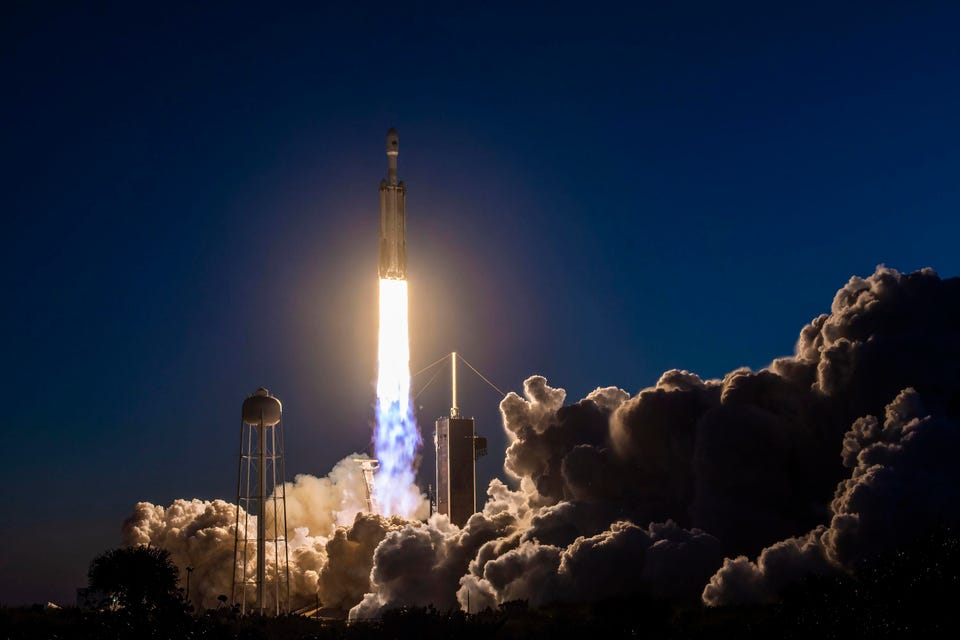Watch The Spectacular SpaceX Rocket Launch As Boosters Return To Earth In Tandem


On Sunday, January 15 at 5:56 p.m. ET, Falcon Heavy launched the USSF-67 mission to a geosynchronous … [+] Earth orbit from Launch Complex 39A (LC-39A) at Kennedy Space Center in Florida.
SpaceX via Twitter
The world’s second-most powerful rocket—though it’s largest partially renewable rocket—yesterday blasted-off on a secret mission for the US Space Force amid spectacular views.
Only the fifth flight of the company’s heavy-life Falcon Heavy rocket (though the second inside a few months), the event took place in twilight Sunday, with a satellite being successfully sent into geosynchronous Earth orbit (meaning it will orbit at the same speed as Earth rotates). Two side-boosters then returned to land in tandem on launch pads.
They were the 163th and 164th successful landings of an orbital-class rocket, according to SpaceX.
The mission, called USSF-67, took a communications satellite into orbit for the US military.
It blasted off from Launch Complex 39A (LC-39A) at Kennedy Space Center in Florida at 5:56 p.m. ET with the side-boosters returning minutes later to two adjacent launch pads in Cape Canaveral.
You can watch the entire spectacular launch and landing on YouTube, but here are some of the spectacular videos and photos from the launch:
Falcon Heavy blasts-off …

A SpaceX Falcon Heavy rocket leaves NASA’s Kennedy Space Center on Jan. 15, 2023, on the USSF-67 … [+] mission for the U.S. Space Force.
SpaceX via Twitter 
A SpaceX Falcon Heavy rocket leaves NASA’s Kennedy Space Center on Jan. 15, 2023, on the USSF-67 … [+] mission for the U.S. Space Force.
SpaceX via Twitter 
A SpaceX Falcon Heavy rocket leaves NASA’s Kennedy Space Center on Jan. 15, 2023, on the USSF-67 … [+] mission for the U.S. Space Force.
SpaceX via Twitter
Then its two side-boosters dramatically land in-sync …
The SpaceX Falcon Heavy was recently relegated from its position as the world’s most powerful rocket by NASA’s Space Launch System (SLS), which recently conducted its first successful flight as part of the space agency’s Artemis-I mission around the Moon.
The SLS is a largest rocket ever constructed, surpassing NASA’s iconic Saturn V “Moon rocket” last used in 1973. Standing 322 ft. high, the SLS offers 8.8 million pounds of thrust.
Falcon Heavy—an amalgamation of three Falcon 9 boosters (only two of which return to Earth) and a second-stage—stands 230 ft. high and offers 5 million pounds of thrust. However, it remains the only heavy-lift rocket that’s partly reusable.
In a bid to drive down costs and speed-up flights, SpaceX has pioneered the use of rocket boosters that return to Earth to be reused. As well as being a tremendous technical achievement, jaw-dropping views of boosters landing back on the launchpad—particularly in tandem after Falcon Heavy launches, such as yesterday’s—has also been a spectacular a PR success for Elon Musk’s private space company.
The biggest moment in SpaceX’s history was arguably the sending of Musk’s own Tesla Roadster—“driven” by a mannequin called “Starman” dressed in a spacesuit—into orbit of the Sun after a test flight of the Falcon Heavy in February 2018. It’s currently orbiting the Sun, though lost in its glare.
Wishing you clear skies and wide eyes.
